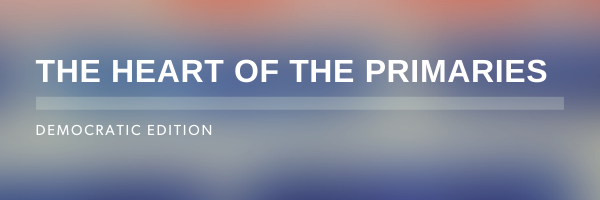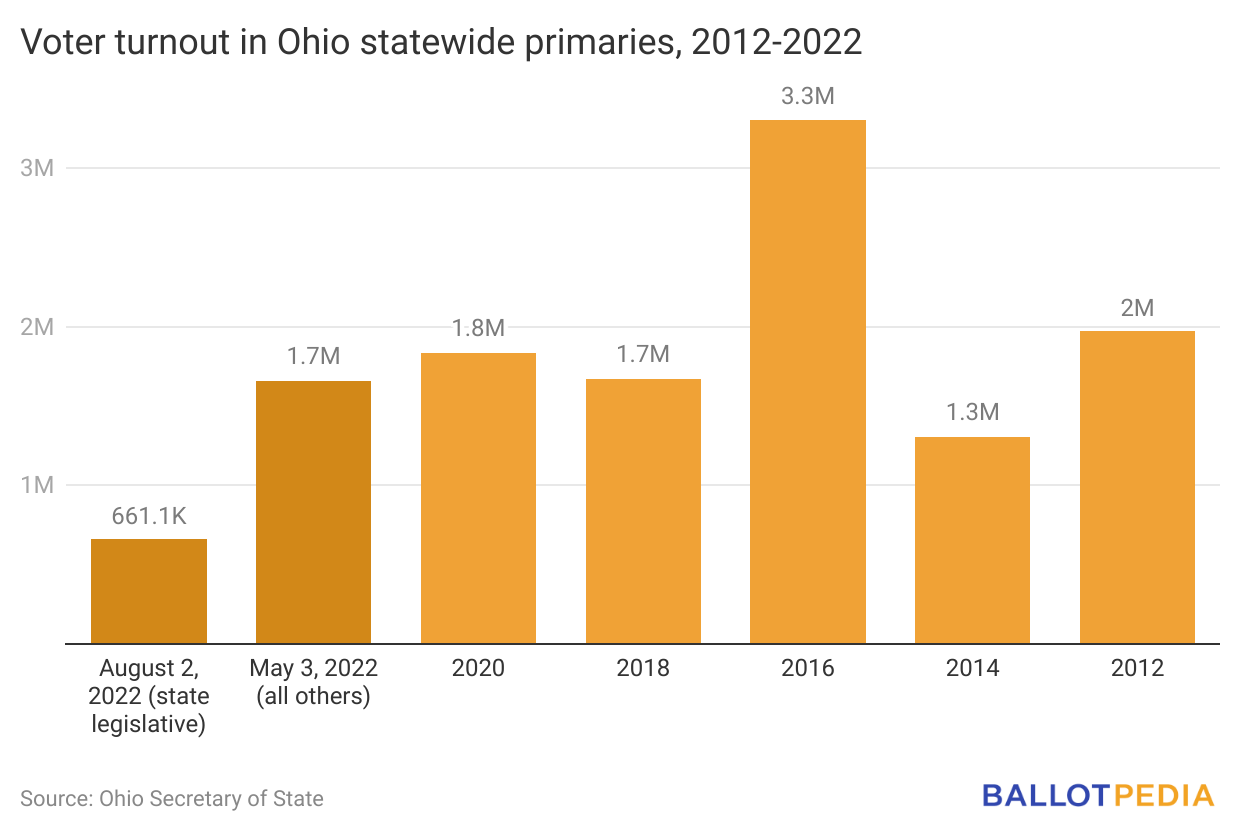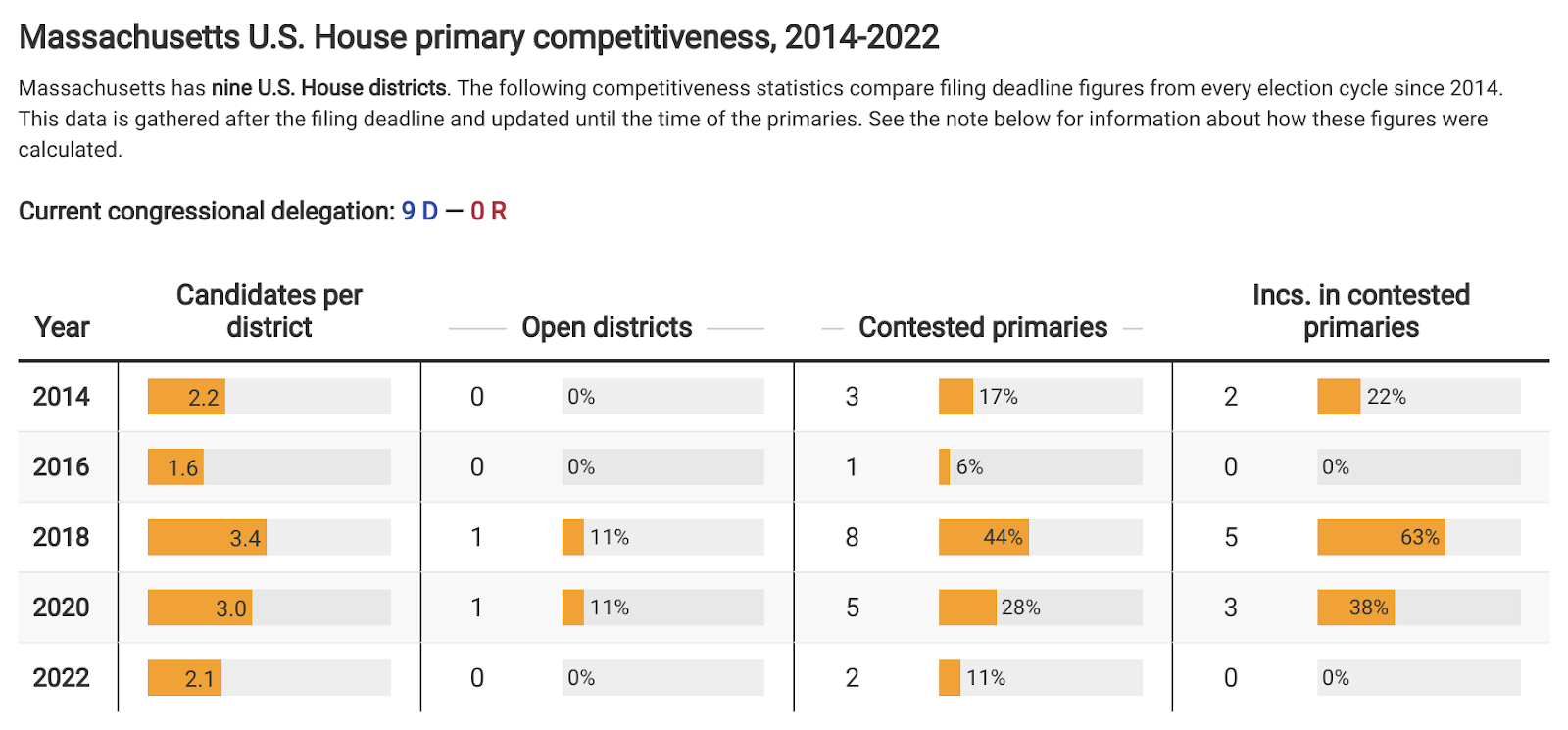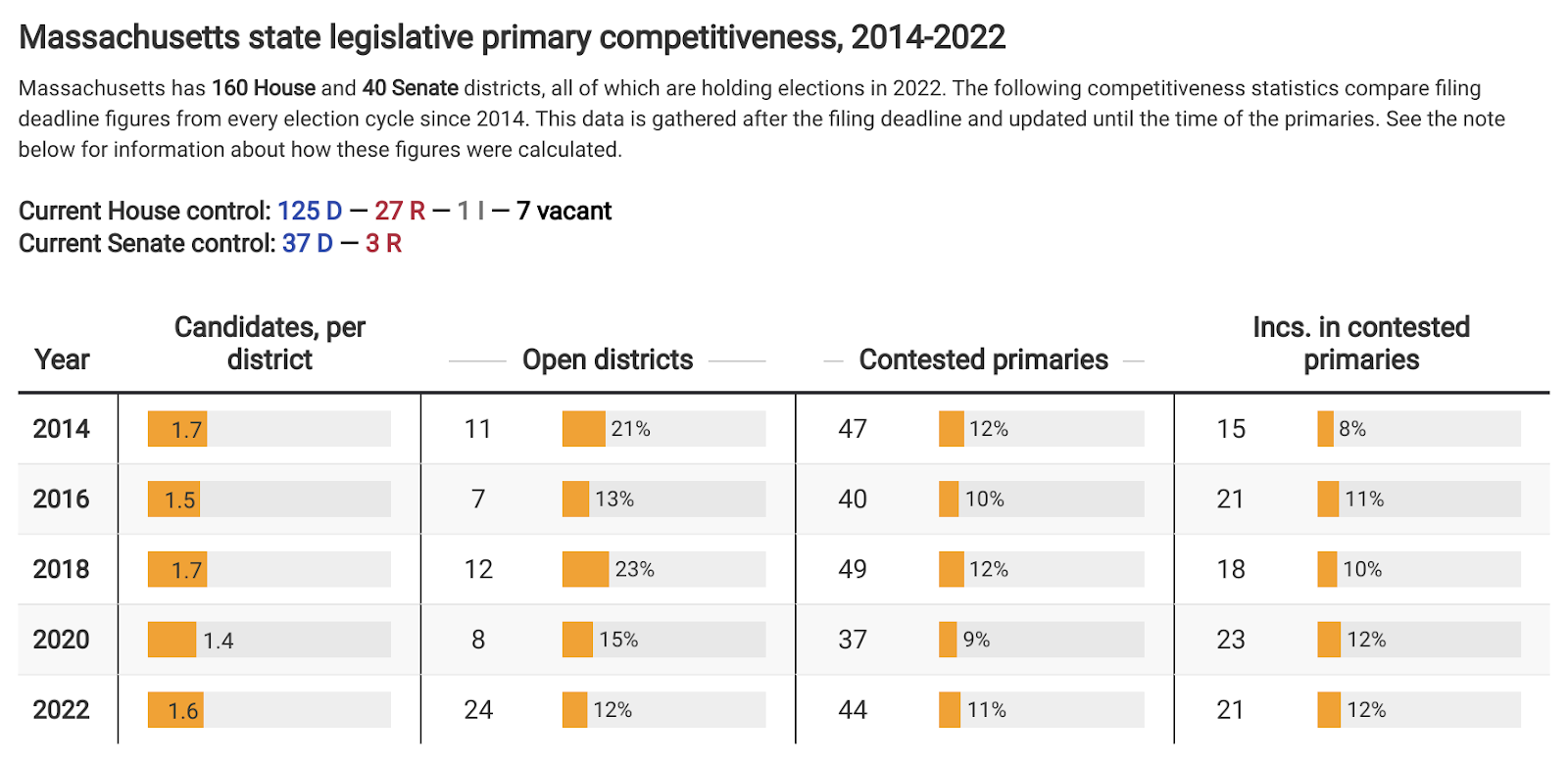|
|
 |
|
|
Welcome to Heart of the Primaries, Democratic Edition
|
|
|
September 01, 2022
|
|
|
|
In this issue: Major endorsement splits in Massachusetts AG primary and a look at turnout in Ohio's split primaries. |
|
|
|
|
|
|
|
BALLOTPEDIA |
|
|
|
|
|
|
Progressive endorsers split, candidate drops out of Massachusetts AG primary
|
|
|
|
|
|
|
Sen. Elizabeth Warren (D-Mass.), Boston Mayor Michelle Wu, and Boston's former Acting Mayor Kim Janey endorsed labor attorney Shannon Liss-Riordan for Massachusetts attorney general. Politico Massachusetts Playbook's Lisa Kashinsky said the endorsements show the primary is "pitting the state’s most prominent progressives against each other."
Incumbent Attorney General Maura Healey (D), Sen. Ed Markey (D-Mass.), and Rep. Ayanna Pressley (D-Mass.) endorsed former Boston City Council member Andrea Campbell.
Campbell, Wu, and Janey served on the city council together and ran in last year's Boston mayoral primary.
On Tuesday, former state Assistant Attorney General Quentin Palfrey announced his withdrawal from the race and endorsed Campbell. Palfrey won the state Democratic Party's backing in June.
Kashinsky said Palfey had "been outpaced in fundraising by Campbell and trounced by Liss-Riordan, who’s now poured at least $4.8 million of her own money into her campaign. And he's trailed in polling while Liss-Riordan is closing the gap with Campbell after blanketing the airwaves since early July."
Also on Tuesday, The Boston Globe editorial board endorsed Campbell.
During debates, candidates have focused on criticizing each other's fundraising and super PAC involvement in the race. On policy, Kashinsky wrote that Liss-Riordan is more supportive of rent control and that Campbell has said she wouldn't interfere with local efforts to implement it. Kashinsky also wrote the candidates had different approaches to combating racism, with Campbell focused on Department of Corrections and prison reforms and Liss-Riordan emphasizing the Attorney General office's civil rights division.
See Boston.com's candidate Q&A here for more.
The primary is Sept. 6. |
|
|
|
|
|
|
Peltola wins special U.S. House election (and other Alaska updates)
|
|
|
|
|
|
|
On Aug. 16, Alaska held top-four primaries and a special U.S. House election, the latter of which used ranked-choice voting. Certification is expected by tomorrow, and most battleground races have been called.
U.S House special general: Mary Peltola (D) won the election. On the final round of unofficial ranked-choice voting tabulation, Peltola had 51.5% of the vote to Sarah Palin's (R) 48.5%. This election fills the term ending Jan. 3, 2023.
Before tabulation began, Peltola had 40% of first-choice votes, followed by Palin with 31% and Nick Begich III (R) with 28%. Write-in candidates received a combined 1.6% of the vote.
Write-in candidates were eliminated first as a batch. Then Begich was eliminated. The votes of those who chose eliminated candidates as first choices were redistributed to the voters' second-choice candidates if they chose such. Watch a livestream of the tabulation from the Alaska Division of Elections here.
Peltola will be Alaska's first Democratic U.S. representative since Nick Begich Sr.—Nick Begich III's grandfather. Begich Sr.'s plane went missing while he was in office in 1972. Don Young (R) won a special election to succeed Begich. Young served until his death in March of this year.
Peltola, Palin, and Begich will meet again in the regularly scheduled general election for U.S. House in November. General elections for all offices below will be held Nov. 8 and will use ranked-choice voting as well.
U.S. House regular primary: As of Wednesday, The New York Times had called three of the four general election spots for Peltola, Palin, and Begich III. Peltola led with 37% of the vote, followed by Palin with 30%, Begich with 26%, and Tara Sweeney (R) with 4%.
Sweeney said she'll withdraw from the race, meaning the fourth spot would go to the fifth-place finisher. As of Wednesday, that was Libertarian Chris Bye, who had 0.6% of the vote. Sept. 2 is the target election certification date, and Sept. 6 is the ballot certification date.
Alaska governor: Incumbent Mike Dunleavy (R), Bill Walker (Independent), Les Gara (D), and Charlie Pierce (R) advanced to the general election. Dunleavy had 41% of the vote, followed by Walker and Gara with 23% each and Pierce with 7%.
Dunleavy was elected governor in 2018. He succeeded Walker, who initially ran for re-election that year and withdrew weeks ahead of the general election. Gara served in the state House of Representatives from 2003 to 2019. Pierce worked as a manager at ENSTAR Natural Gas Company.
U.S. Senate: Incumbent Lisa Murkowski (R), Kelly Tshibaka (R), Patricia Chesbro (D), and Buzz Kelley (R) advanced to the general election. Murkowski had 45% of the vote, followed by Tshibaka with 39%, Chesbro with 7%, and Kelley with 2%.
Murkowski first took office in 2002. Tshibaka is a former commissioner at the Alaska Department of Administration. Chesbro is a retired teacher. Kelley is a retired mechanic.
Murkowski is the only Republican senator seeking re-election this year who voted guilty during former President Donald Trump's 2021 impeachment trial. Murkowski's endorsers include U.S. Senate Minority Leader Mitch McConnell (R) and Sens. Dan Sullivan (R-Alaska), Joe Manchin (D-W.V.), and Kyrsten Sinema (D-Ariz.). Trump and the Alaska Republican Party endorsed Tshibaka. |
|
|
|
|
|
|
FL-04 recount shows Holloway still in lead
|
|
|
|
|
|
|
On Aug. 27, Clay, Duval, and Nassau counties' canvassing boards conducted a machine recount of Florida's 4th Congressional District Democratic primary votes. LaShonda Holloway remained in the lead, ending the recount with 207 more votes than Anthony Hill.
According to state law, a recount must be conducted when the margin of victory is less than or equal to 0.5% of the total votes cast. The 201 votes separating the candidates as of last week equaled around 0.34% of the total cast in the primary.
The winner faces Aaron Bean (R) in November. Election forecasters view this as a Safe Republican district.
This was one of several congressional primary recounts that have taken place this year. In addition to high-profile recounts in Pennsylvania's U.S. Senate Republican primary and Texas' 28th District Democratic primary runoff, others included Florida's 22nd District GOP primary, Texas' 15th District Democratic primary runoff, Wisconsin's 2nd District GOP primary, and Georgia's 10th District Democratic primary. |
|
|
|
|
|
|
Ohio's state legislative primary voter turnout decreased amid split election
|
|
|
|
|
|
|
Due to redistricting-related court challenges, Ohio held two primaries this year. The first, its regularly scheduled primary, took place on May 3 for all except state legislative offices. State legislative primaries occurred on Aug. 2. Turnout in the May 2022 primary was comparable to 2018 and 2020 primary turnout, while state legislative primary turnout specifically was lower this year than in 2018 and 2020.
The chart below compares unofficial voter turnout numbers in the Aug. 2 primary with official turnout numbers in the May primary, along with the official turnout numbers in the state’s previous primary elections through 2012.

Ohio’s Aug. 2 primary had the lowest voter turnout in a statewide primary election in at least a decade, with 661,101 votes cast. A look at votes cast in General Assembly elections in previous years shows that fewer people voted in these primaries in 2022. Votes cast in state Senate elections were 38% of the 2020 figure and 46% of the 2018 figure. In state House elections, 2022 primary votes were 41% of the 2020 figure and 45% of the 2018 figure. The chart below shows the total votes cast in state House and state Senate elections in 2022, 2020, and 2018.

Note: Ohio holds elections for all state House districts and half its state Senate districts in even-numbered years.
The Ohio Redistricting Commission's state legislative maps underwent a lengthy legal challenge process involving several map submissions to the Ohio Supreme Court. A federal court order went into effect on May 28, selecting one of the submitted maps for use in the 2022 elections. The legal challenge to the legislative maps is ongoing before the state supreme court.
Ohio is one of two states that split its primaries this year due to redistricting legal challenges. Statewide turnout data is not yet available in New York, which held primaries on June 28 and Aug. 23. |
|
|
|
|
|
|
Competitiveness data: Massachusetts
|
|
|
|
|
|
|
We’ve crunched some numbers to see how competitive Massachusetts’ Sept. 6 primaries are compared to recent cycles.
 
Notes on how these figures were calculated:
-
Candidates per district: divides the total number of candidates by the number of districts holding elections.
-
Open districts: divides the number of districts without an incumbent running by the number of districts holding elections.
-
Contested primaries: divides the number of major party primaries by the number of possible primaries.
-
Incumbents in contested primaries: divides the number of incumbents in primaries by the number seeking re-election in the given election cycle.
|
|
|
|
|
|